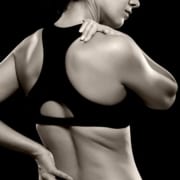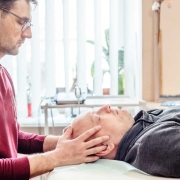Physical Therapy: The Right Touch For Your Musculoskeletal Pain
Pain can come in many forms; it can be the result of an injury, surgery, or an illness; it can be intense pain or a subtle ache; it may be acute or longstanding, localized or widespread. However it manifests, the bottom line for anyone in pain is: the sooner the recovery, the better the quality of life.
Pain is often an indicator of an imbalance somewhere in the musculoskeletal system. Our body’s magnificent framework is made up of bones, muscles, joints, tendons, and ligaments that work together to provide stability, put us in motion, and support the proper functioning of all our vital organs and their systems. When there is an imbalance the body overcompensates, eventually causing fatigue, inflammation, and dysfunction in the area.
Physical therapy offers undeniable value when treating musculoskeletal pain. With extensive training in manual skills and a comprehensive understanding of body mechanics, physical therapists can treat a wide range of musculoskeletal pain problems. For example, there are physical therapists who help patients recover from sports injuries or strokes, others who work primarily with patients suffering from pelvic floor dysfunction, and those who specialize in Craniosacral Therapy, which may provide symptomatic relief from chronic neck and back pain, migraine headaches, fibromyalgia, temporomandibular joint syndrome (TMJS), and traumatic brain injuries, among many other conditions. While some physical therapists specialize in working with children and infants, others work primarily with adult or geriatric patients.
“Physical therapy is a dynamic profession with an established theoretical and scientific base and widespread clinical applications in the restoration, maintenance, and promotion of optimal physical function.” – American Physical Therapy Association (APTA)
Fundamental benefits of PT
Encourages physical activity
PT requires movement! The inclination may be to take time off from exercise when in pain. However, physical therapists are able to “prescribe” exercise programs appropriate for a patient’s specific medical condition. With the right program and under the right guidance, the body continues to move, which promotes heart health, bone health, mental health, and more. In other words, staying active is critical for healing and for lowering the risk of other illnesses in the future.
Promotes natural healing
PT, like other alternative therapies, promotes the body’s natural healing process and does not come with the cost and risky side effects of powerful pain medications and invasive measures like surgery and injections. Because of the massive opioid crisis, in 2016 and again in 2022, the Centers for Disease Control changed its clinician guidelines to recommend physical therapy and other nonpharmacological therapies as a first line of treatment for chronic, non-cancerous pain conditions. While there is an appropriate time to consider opioids for acute pain management, physical therapy should be the first line of treatment for musculoskeletal pain, and, depending on your condition, may very well be the only treatment you need.
Restores function
PT teaches individuals about body mechanics for sitting, standing, and lifting. Patients are educated about their body’s limitations and given an individualized program that will gradually improve their range of motion, muscle strength, and stability for a faster and more complete recovery so they can reengage in life.
Teamwork makes the dream work!
Teamwork is defined as “the combined actions of a group of people working together effectively to achieve a goal.” Working with a physical therapist will provide instruction, encouragement, and consistency in your healing process.
In sum
Fundamental health relies on a healthy musculoskeletal system so that other critical systems, like the neurological, circulatory, and hormonal systems, can function properly too. Physical therapists are expertly trained to locate and rehabilitate deficiencies in the musculoskeletal system for a more complete recovery.
If you have a pain problem, your physician should take a thorough medical history, including asking questions about the special characteristics of your pain, including its duration and the particular sensations you are experiencing. This will not only help to accurately identify the cause or causes of your pain problem but will also eliminate other possibilities. If physical therapy is in order, your doctor can help you find a physical therapist with the right set of skills to meet your medical needs.
To schedule an appointment with a Kaplan Center physician to see if physical therapy is appropriate for you, please call 703-532-4892. Physical Therapy orders from non-Kaplan physicians can be used for treatment here.
We are here for you, and we want to help.
Our goal is to return you to optimal health as soon as possible. To schedule an appointment please call: 703-532-4892 x2
This article was originally published in October 2018. It was reviewed and updated in October 2023.


